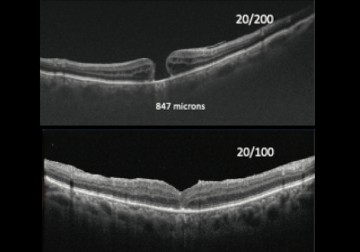In a new study from LVPEI, Drs. Mudit Tyagi, Nikitha Gurram Reddy, and Niroj Kumar Sahoo have developed a new method of closing macular holes after surgery using fibrin-glue, a biological adhesive. The technique removes most problems associated with gas tamponade, the usual method for closing macular holes.
The macula is the central zone in the retina that processes central vision-you are reading this text thanks to your macula. Changes in an ageing eye can lead to the development of macular ‘holes’-a few hundred microns in diameter-that can impair vision. An ageing vitreous, the ‘gel’ that maintains the shape of the eye, can induce a posterior tractional ‘tug’ on the retinal surface. Over time, this infinitesimal force creates clefts in the retina, which may be further pulled apart by tangential traction in the epiretinal membranes. This results in ‘holes’ in the macula that need surgery, a vitrectomy, to correct.
In a vitrectomy, the vitreous is drained, and often, the internal limiting membrane (ILM) and the epiretinal scar tissue are peeled away, removing tangential traction. A gas bubble tamponade is injected into the eye to temporarily replace the vitreous. The bubble maintains ocular shape, relieves tractional pressure on the macula, and squeezes the macular hole together, helping it heal. It takes about two weeks for the gas to dissipate and for the vitreous to re-fill the ocular chamber. So, patients with a gas tamponade are advised to lay face-down for up to a week to keep the gas bubble in position. Enduring a face-down posture for extended periods can be distressing at best and, in the worst cases, may be very difficult for people with disabilities or other age-related issues. Patients with a gas tamponade need to avoid air travel for 2-4 weeks as well.
A new, prospective study published in the journal Seminars in Ophthalmology by Drs. Mudit Tyagi, Nikitha Gurram Reddy, and Niroj Kumar Sahoo of LVPEI explores an alternative that does not require an extended face-down position post-vitrectomy. The authors describe a novel surgical technique for closing macular holes using fibrin glue after ILM peeling. Fibrin glue is a biological adhesive composed of thrombin and fibrinogen, naturally occurring proteins necessary for blood clotting. In a previous study, Dr. Tyagi and others had used fibrin glue to repair retinal detachments. In this study, they propose injecting fibrin into an air-filled globe over the macular hole.
Ten patients (10 eyes) with idiopathic macular holes were included in this prospective, non-comparative, consecutive case series over a 20-month period (Jan 2020 - Aug 2021). All patients were 47-81 years of age (median age: 62.5). In this procedure, the holes were closed after ILM peeling using fibrin glue, and in six cases, with an inverted ILM flap as well-no gas tamponades were used in any of the cases. The patients were not asked to maintain a face-down position, and yet, the macular holes were successfully closed in 8 out of 10 eyes. The visual acuity of the eight eyes improved from a median of 20/100 to 20/60 (normal: 20/20) one month after surgery.
‘This pilot study opens new possibilities for macular hole treatment that increases patient comfort and can be a boon to patients who are unable to maintain a prolonged face-down position,’ says Dr Mudit Tyagi, Head, Smt. Kanuri Santhamma Centre for Vitreo-Retinal Diseases at LVPEI, and the corresponding author for this paper. ‘It also allows for an early visual recovery and for an early resumption of air travel.’
Citation
Tyagi M, Reddy NG, Sahoo NK. Fibrin-Glue-Assisted Surgery for Idiopathic Macular Holes. Semin Ophthalmol. 2023 Oct 21:1-4.



